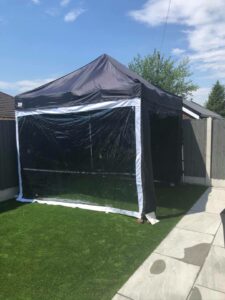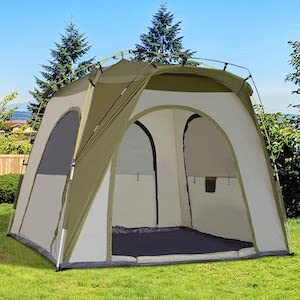A gazebo has a natural habit of being outside, so you would think that it would be fully waterproof. How wrong that assumpion is. Wether you use your gazebo for camping, market stalls or exhibitions check out our waterproofing guide to looking after your important investment.
If you’re a camping enthusiast or plan to give camping a go, few excursions that are focused on communing with Mother Nature are more satisfying than camping. You can camp alone or with a mate, or you can create lovely memories for your entire family by spending quality time outdoors. One of the few things that can stand in the way of you and a good time camping is rain.

What do you need to waterproof your gazebo?
Waterproofing your gazebo is quick and easy, and you won’t need any expensive tools to get the job done. You may already have what you’ll need, but if not, you can usually find all you need at your local ironmonger, chemist, outdoor supply store, general merchant, or shoe store.Note: We are not talking about hard top gazebos in this article as they require different tratement depending on material used. Here’s what you need:
- Waterproof Proof paint – we recommend Fabsil Tent Waterproofer
- A can of rust-preventative spray paint
- A pair of gloves is optional but recommended
- If your gazebo is tall, you may need a ladder to work with the cover material or reach all the areas you must
- Because you’ll be spraying aerosols, it is optional but it’s a good idea to wear a face covering
- A work area large enough to spread out your gazebo’s canopy
How Do You Reach The Top Canopy of The Gazebo?
Most pop-up gazebos consist of pieces of polyester (is polyester waterproof?) or canvas attached to a lightweight metal frame, often aluminium. The fabric is usually stretched across the frame and held in place with snaps and Velcro loops. Removing the material and preparing to waterproof it is a three-step process:
- Unhook the snaps and Velcro loops that attach the cover material to the frame
- Carefully slide the cover material up and over from one side until it slips off the opposite side
- Spread the cover material on the ground. If the ground is wet or muddy, first lay down a tarp and then place the cover material on top
What about the frame?
Before you start waterproofing your cover material, you should make sure that your newly waterproofed material will be going back onto a good frame. This is easy:
- Inspect the frame to see if there are any rust spots
- Lightly sand off any rust
- Spray rust-preventative paint on the sanded areas. Hold the spray nozzle at a 45-degree angle to the frame and about 8 inches away. Sweep back and forth with the can to create a smooth, dripless finish.
- Allow the frame to dry while you turn your attention to waterproofing your cover material. You can get spray paint that dries to the touch in 30 minutes or less and can be handled in an hour or two.
How do you apply the waterproofing material?
Let’s start with a tip. If the piece of material that you are waterproofing is too large for you to easily reach all of it, you should do this:
- Roll the edges of the material from the outside toward the center. Stop rolling when the exposed area is small enough that you can reach all of it.
- Treat the area in the middle, then roll out the sides to expose additional segments that you can reach. Keep rolling it out until you complete the treatment.
Here’s how you go about treating your material with waterproofing spray:
- Shake the can vigorously. You will know you’ve shaken enough when you can hear the ball bearing clanging inside the can.
- Hold the can over the area you are treating at a 45-degree angle about 8 inches above the material
- Push down the nozzle with your finger and then sweep the can back and forth in a nice, even motion
- Apply a heavy coat of waterproofing to all of the material. Products may differ, so read the manufacturer’s instructions about how much to apply and to learn how long it takes for the product to dry before you apply a second coat
- Apply a second coat of waterproof spray. Pay special attention to the seams because stitches are most prone to letting water seep through.
Completing your project
When your newly waterproofed material is dry, place it back on the frame by simply reversing the steps you took to remove it. Check out our guide to Gazebos and Shelters.Conclusion
Waterproofing your camping equipment is a fast, easy, and inexpensive project. It helps ensure that you stay dry in the Great Outdoors and extends the life of your gear.



